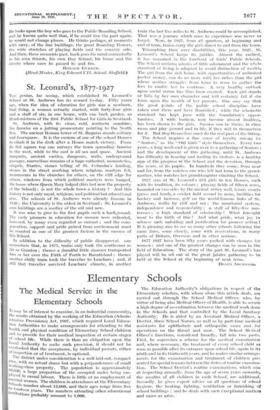St. Leonard's, 1877-1927
THE genius, far seeing, which established St. Leonard's School at St. Andrews has its reward to-day. Fifty years ago, when the idea of education for girls was a newborn, frail thing, a woman actually started, with forty-four girls and a staff of six, in one house, with one back garden, as Head-mistress of the first Public School for Girls in Scotland.
St. Andrews, with its clear, cold, northern sunshine, lies fanwise on a jutting promontory pointing to the North Sea. The ancient Roman tower of St. Regulus stands solitary and foursquare. It is the custom of one of the school Houses to climb it in the dark after a House match victory. From its flat square top one surveys the town spreading fanwise to the west, while to the east is all sea and space. Ancient ramparts, ancient castles, dungeons, walls, underground passages, marvellous remains of a huge cathedral, monasteries, chapels, friaries, stones telling of St. Columba's landing, stones in the street marking where religious martyrs fell, monuments in the churches for others, on the cliff edge for others, windows from which political martyrs were hanged, the house where Queen Mary lodged (this last now the property of the School) : is not the whole town a history ? And this history is not only royal, religious, and political but educational also. The schools of St. Andrews were already famous in 1120 ; the University is the oldest in Scotland ; St. Leonard's own buildings are a medley of the old and new.
It was wise to give to the first pupils such a background. The early pioneers in education for women were ridiculed, harassed, by many even regarded as outcast ; and the com- pensation, support and pride gained from environment must be counted as one of the greatest factors in the success of this School.
In addition to the difficulty of public disapproval, one remembers that, in 1877, trains only took the southerner as far as Granton ; thence a dreadful little steamer transported him or her over the Firth of Forth to Burntisland ; thence another chilly train took the traveller to Leuchars ; and, if still that traveller survived Leuchars' climate, in another
train the last five miles to St. Andrews could be accomplished. That was a journey which once to experience was never to forget. -Now, in 1927, from all quarters, at beginning and end of term, trains carry the girls direct to and from the town.
Triumphing then over disabilities, this year, 1927, St, Leonard's School keeps its jubilee. Almost the earliest, it has remained in the forefront of Girls' Public Schools. The School uniform admits of little adornment and the whole standard of living is adapted to avoid distinction of wealth. The girl from the rich home, with opportunities of unlimited pocket money, can do no more with her riches than the girl whose mother • struggles from term to term to gather the fees to enable her to continue. A very healthy outlook upon social status has thus been created. Each girl stands or falls by her own character and will certainly fall if she leans upon the wealth of her parents. One may say that the good points of the public school discipline have taken root there and have flourished ; while the scholastic standard has kept pace with the foundation's oppor- tunities. A wide horizon, now become almost limitless, has been shown to the girls. Success can be theirs, in class room and play ground and in life, if they will fit themselves for it. But they themselves must do the real part of the fitting.
The School inspires a fine sense of loyalty among its "Seniors," as the "01d Girls" style themselves. Every two years, a long week-end is given over to a gathering of Seniors ; and the development of this gathering, until St. Andrews has difficulty in housing and feeding its visitors, is a healthy sign of the progress of the School and the devotion, through the years, of its pupils. In hundreds they come, from near and far, from the voteless one who left last term to the grand- mother, who watches her granddaughter climbing the School.
1927 secs at St. Leonard's 375 girls in ten Houses, each with its tradition, its colours ; playing fields of fifteen acres, bounded on two sides by the ancient abbey wall, tennis courts (grass and hard), a cricket field second to none, facilities for hockey and lacrosse, golf on the world-famous links of St. Andrews, walks by cliff and sea ; the monitorial system, independence and responsibility ; a staff of fifty-five mis- tresses ; a high standard of scholarship ! What foresight went to the birth of this ! And what pride, what joy to witness such unfolding and justification for pioneer action ! It is pleasing also to see so many other schools following the same lines, some closely, some with reservations, in many parts of Britain, Overseas and in other nations.
1877-1927 have been fifty years packed with changes for women ; and one of the greatest changes can be seen in the field of Education. The story of the part St. Leonard's has played will -be set out at the great jubilee gathering to be held at the School at the beginning of next term.
HELEN' ARCHDALE.


























































 Previous page
Previous page